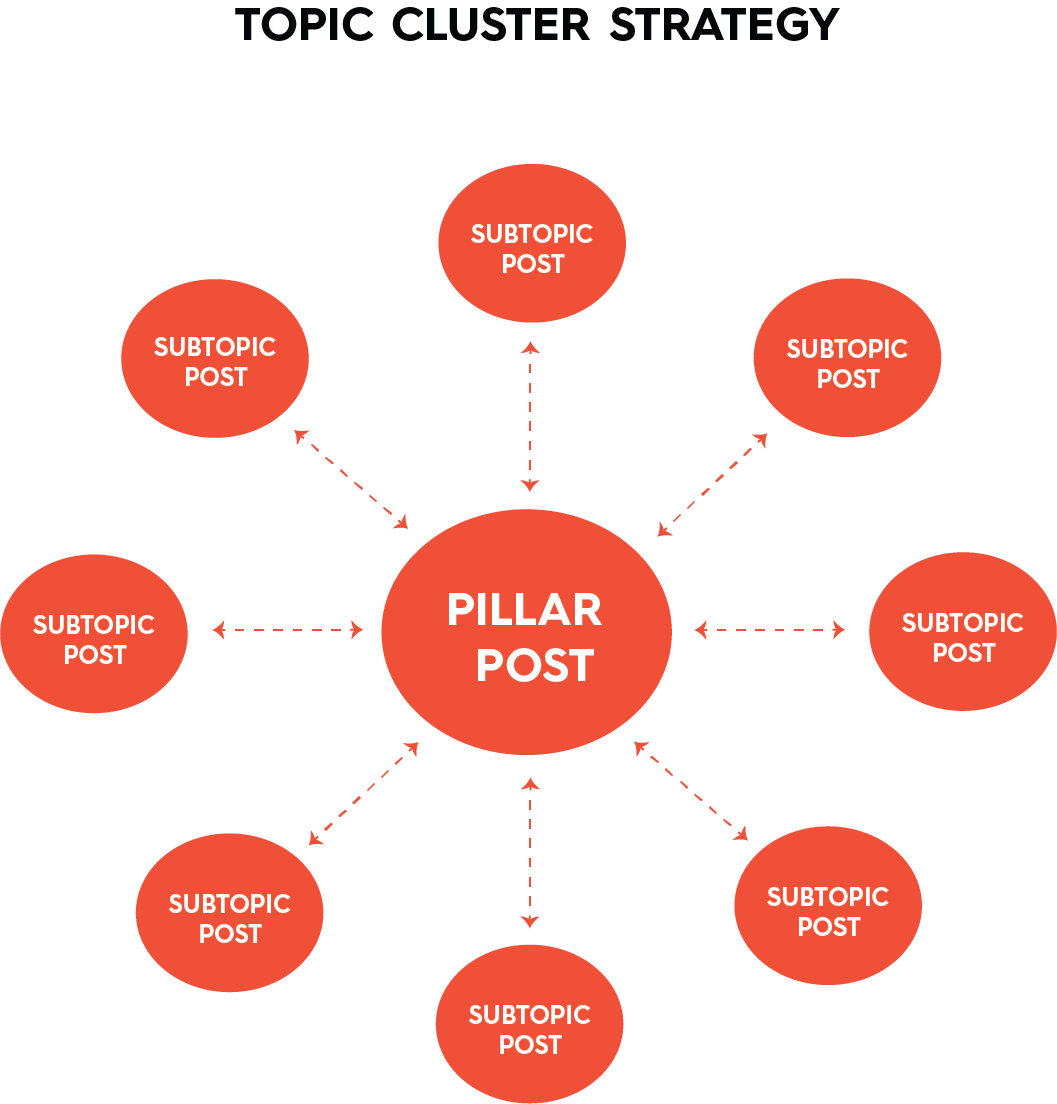SEO marketing is as important as ever—and more competitive than ever. As AI-generated content floods search engines, brands have to fight harder for visibility online. That’s why you need to build a smart SEO strategy driven by your goals and your audience’s needs. But in the ever-changing world of SEO, it can be challenging to keep up with the latest best practices. That’s why we did the work for you, diving into the latest algorithm updates and data-based tips to give you the cheat sheet you need to master SEO.
TOC
- What Is SEO?
- What Are the Different Types of SEO?
- What Type of Content Ranks for SEO?
- What Is the Best Strategy to Build SEO?
- How to Create an SEO Strategy
- How to Maintain Your Rankings
Now before we dive in, let’s take a little refresher.
What Is SEO?
Search engine optimization (SEO) is the process of optimizing your website and content to increase visibility for search engines. The higher you rank in search engines, the more people can find your brand, and the more organic traffic you’ll get. In essence, SEO is a strategy for getting people to your website—and, ultimately, getting them to convert.
What Are the Different Types of SEO?
There are three general categories of SEO:
- On-page: The things you do to optimize a single page, such as keyword, titling, etc.
- Off-page: The ways you improve rankings outside of your website, such as sourcing backlinks.
- Technical: The ways you optimize your website from a technical perspective, such as improving load time, image compression, etc.
For this article, we’ll mainly be talking about on-page SEO. (If you want to increase your off-page SEO, find out how to promote your content like an agency would.)

What Type of Content Ranks for SEO?
In SEO marketing, if you want to rank well, you need to create high-quality content. This has been Google’s mantra for years as it aims to serve only the best, most relevant search results to their audience. But what exactly does that mean?
Several factors affect Google rankings, but in general, Google will always favor quality content that demonstrates EEAT (Experience, Expertise, Authoritativeness, Trustworthiness).
1) Experience
This refers to the author’s first-hand experience with the topic.
For example, let’s say you want to buy a new vacuum. You might start your Google search and see an article titled “Top 10 Vacuums of the Year,” which details the technical features of each vacuum. That seems pretty straightforward. But if you see an article titled “I Tried Every Top 10 Amazon Vacuum to Clean My Apartment” with a detailed explanation of personal pros and cons, you’d probably click on the personal experience one to get the “real” truth.
As AI-generated content and generic “thought leadership” have flooded the Internet, people are thirstier to hear from real people about real experiences. Injecting your experience is one of the biggest things that will set you apart.
2) Expertise
This refers to the author’s expertise on a topic they are writing about. This differs from experience, as a non-expert can write about their experience with something. However, the most effective content blends expertise and experience.
For example, using the previous example, an article titled “A Pro House Cleaner Breaks Down Their Favorite Vacuums of the Year” perfectly blends expertise and experience.
3) Authoritativeness
This refers to your brand’s reputation in your industry (compared to other websites/sources). Getting backlinks from other reputable sites contributes to your site authoritativeness.
4) Trustworthiness
This refers to your overall trustworthiness, including the accuracy of your content, your brand credibility, sources, transparency, etc.
For example, because people only want to interact with sites they trust, having a secure site, an about page, and a clear way to contact you helps increase your trustworthiness.
As you build your SEO strategy, any content you create should be written through an EEAT lens to ensure you’re delivering quality, value, and transparency to your audience.
What Is the Best Strategy to Build SEO?
SEO marketing has undergone several evolutions in the last decade, but as quality content has become the North Star for ranking, the best SEO strategies are built to deliver quality and value to your audience. The smartest way to do this is to create topic clusters, wherein you create a series of interlinking pages crafted around a specific topic in your area of expertise. Each cluster includes a pillar page, which provides a comprehensive overview of the topic, as well as associated pages that dive into subtopics.
These pages link to and from the pillar page, helping to increase visibility and create a strong, comprehensive ecosystem of content.

Topic clusters are important because they help establish your area of expertise. They create a variety of “entry points” for your audience to find you as they search for information. And they allow you to create rich, quality content that search engines love.
However, topics should not be arbitrarily chosen. They should be informed by thorough research to identify the keywords your audience is most interested in.
How to Create an SEO Strategy
Now that we’ve covered the foundations, let’s dive into how you can craft a winning SEO strategy from scratch—and keep it going.
Step 1: Choose the right keywords.
In general, there are four categories of keywords:
- Informational: People are looking for information about a subject.
- Navigational: People are looking for a specific website.
- Commercial: People are searching for information about brands, products, services, etc.
- Transactional: People are looking to purchase or take an action (e.g., buy or subscribe).
To build a smart SEO strategy, you should focus on two key categories of keywords:
- Informational keywords: These keywords relate to the evergreen topics and questions that your audience will always want to know about. These are the best keywords for your topic clusters.
- Commercial/transactional keywords: These are the specific keywords people are searching for when they want to buy a product/service.
Targeting these categories ensures you’ll be able to reach people at the top of the funnel and further down the buyer journey.
One note: It is crucial to build an SEO strategy around the topics/keywords that your audience is actually searching for. (Too often marketers only think about what they want to target.)
To determine the best keywords, you want to look at the words you currently rank for and those you want to rank for.
1) Look at commercial/transactional intent keywords. These keywords tend to have lower search volume, but the people who use them are more likely to convert. Targeting commercial/transactional keywords can help you find the low-hanging, easy-to-rank-for keywords that align with your goals.
2) Look at words your competitors rank for. Your competitors can be your greatest source of inspiration, as you can target the words they rank for—and target the words they’re not ranking for.
3) Research the topics your audience wants to know about. These are the topics to turn into clusters. There are multiple ways to find out what people are interested in.
- Customer data and feedback: Look at the terms people are currently using to get to your site.
- Google Search Console: Look at search results/search queries to find out what people are searching.
- Answer the Public: Type a subject into this tool and it will generate related questions around a certain topic.
Regardless, as you’re searching these keywords, consider:
- Which topics are relevant and important to your brand?
- Which topics have worked well in the past?
- What content do you already have, and what content are you missing?
- Which topics matter most to your target audience?
- Which topics do your competitors talk about?
Note: Your own SEO tool likely has a feature to serve you keyword ideas too.
4) Curate your list. Once you have your list of desired keywords, assess each keyword to determine search volume, difficulty, and relevancy. With this data, you can curate the right list for your audience and your brand goals.
For more step-by-step details on how to find the right keywords, see our guide to creating a strong keyword strategy.
Step 2: Create quality content.
Once you have your keyword list, it’s time to build your editorial calendar and start creating that content. As you embark on content creation, ensure you’re creating EEAT-centric content that will rank.
1) Analyze content that has already been created around the keyword you want to rank for. You may be inclined to just start writing, but it’s important to understand what content already exists on the subject. Take a look at the page 1 articles that are currently ranking, and think about what you can expand on or ways to add your unique spin to the conversation. Look at the headlines, tone of voice, article length, formatting, longtail keywords, etc. to see how you can stand out.
2) Build out your content, one keyword at a time. As you approach each keyword, brainstorm the most relevant angle. Per SEMRush research, these are the highest-ranking post types:
- “Everything You Need To Know About _____” posts rank highest. It is the least common post type because it needs to be comprehensive, but these are exactly the types of topic cluster pillar pages you want to create.
- “Mistakes To Avoid” posts get the most shares.
- How-to, guides, and comparison posts attract the most backlinks.
- Listicles are enticing and always clickable.
Some topics are more conducive to certain formats than others, but it’s important to know your angle before you start writing.
3) Add more EEAT.
Many marketers mistakenly believe that any content they create is good thought leadership. Oftentimes, it isn’t all that good or true thought leadership. (Spoiler: If AI can write it, it isn’t true thought leadership.) So, if you want to make your content more enticing, think about ways to increase the EEAT.
- Experience: Add real-life examples, case studies, proprietary data, lessons learned, etc.
- Expertise: Share your unique perspective, credentials, etc.
- Authoritativeness: Think about trending topics or hot takes that other people and publications would be interested in linking to.
- Trustworthiness: Make sure your site is secure, be clear about who is writing your content, what their credentials are, etc.
Remember, too, that your tone of voice and writing style also influence the way people experience your content.
Step 3: Optimize your content per best practices.
Your SEO tool should help you optimize your content effectively, but there are plenty of other things to consider to improve the way your content ranks.
- Length: Word count is not the single most defining factor, but it does contribute to perceived quality. Analyze the top-ranking articles for your keyword to determine the best length. Otherwise, the general guidelines are:
- Regular articles: 1500-2,500 words.
- Pillar pages: 3,000+ words generate the most traffic.
- Readability: Use headers, short paragraphs, and tight sentences to allow for more white space. You want to make it easy to skim.
- Open articles with a strong hook, stat, or attention-grabbing statement.
- Use bulleted lists to break things up, condense content, etc. Articles with 3-4 bullet lists rank better.
- Add a clickable TOC list for longer posts.
- Include a variety of headings (H2s, H3s, H4s) and include your keyword in them.
- As you structure your article, think about the questions you are answering for the audience, the subjects you are addressing, and the logical order for that information. This can help you create your header structure.
- Headlines: Use an emotional hook, controversial perspective, surprising statistic, or newsworthy hook.
- Include your keyword.
- Make it 60 characters or less (consider how it will display on desktop vs. mobile).
- Include data or numbers. Data, as well as the words “research” and “study,” are more likely to be clicked on (e.g., “New Research Shows a 125% Increase in AI Use”).
- Use Coschedule’s free headline analyzer tool.
- Visuals: Add visuals where you can, as posts with images and video tend to perform better.
- Add at least 3 images per post. Articles with 7+ images get the most backlinks.
- Optimize images.
- Name the image file with hyphens, keywords, and appropriate description (e.g., black-dog-red-collar).
- Compress images (plugins like Resize Image After Upload are helpful).
- Add alt tags using 125 characters or less. Naturally describe the image with relevant keywords.
- Good: “black dog wearing a red collar”
- Bad: “dog canine red collar leather collar small collar leash”
- Internal links: Add at least 5 internal links to additional content on your website per post.
- URL length: Use shorter URLs for posts. They perform better.
- Publishing frequency: The algorithm wants you to publish a steady volume of fresh content. (Research shows publishing one article a day gives you the best chance at ranking.) But quality matters most. In general, 2-4 articles a week is likely the sweet spot.
Note: Optimizing a post is its own artform. That’s why we recommend writing a first draft, then taking an “optimization” pass just to ensure you’re meeting the right criteria.
Step 4: Maintain your rankings.
You can’t just publish an article and wait for it to reach number one. Your SEO content is like a garden. It constantly needs to be fed, tended to, refreshed, pruned, etc.
1) Set up reports to monitor keyword success. Create a custom report with your SEO tool and review it monthly to see how your content is trending.
2) Try to bump up borderline posts. You want to keep an eye on posts that are close to falling off of page 1 or 2. They may need to be reoptimized to maintain your rankings.
Tip: Screaming Frog’s Spider Analyzer will analyze 500 of your posts for free to identify good candidates.
3) Update/reoptimize older posts. Review/update popular content every 6-12 months to ensure content is fresh and reflects your current perspective. There are quite a few ways to update posts:
- Refresh headlines.
- Add additional content.
- Update or add images.
- Add internal links.
Once updated, make sure to update the publish date in WordPress. This tells Google it’s new. That said, don’t update the publish date more than once every 6-12 months.
Above all, be patient and stay up-to-date on best practices. SEO is a never-ending game, and things will continue to change as Google updates its algorithm. What matters most is tenacity and an eye on the long-term prize.
But if you need a little help along the way, consider bringing in a helpful partner. If you’re on the hunt, hit us up. We’d be happy to give your SEO the boost it deserves.





